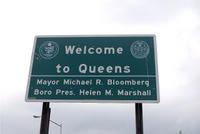 A REal GOod Neighborhood & Some Family Business
A REal GOod Neighborhood & Some Family BusinessAs I've said before, the purpose of this blog is to generate interest and excitement for our ministry in Queens as well as to provide updates on what we are doing as the church plant moves forward. Although our church will be in Forest Hills, we are hoping to reach the surrounding neighborhoods as well. To that end, I profiled Kew Gardens (where I live) a few entries ago. This week, we'll explore Rego Park.
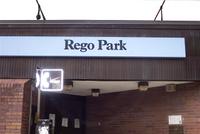
The story of Rego Park is essentially a snapshot of Queens, all the way down to origin of the name Rego Park.
In 1925, the Real Good Construction Company purchased a large plot of land between Elmhurst and Forest Hills. The inhabbitants of the area were largely Chinese immigrant farmers who sold their fruits and vegetables to merchants in Chinatown.
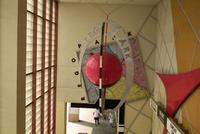
As the company developed the area, it was naturally promoted as a REal GOod place to live. Hence, Rego Park.
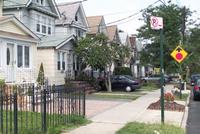 Although there are several homes like these (typically Queens-like), that conjure up images of Archie and Edith around the piano singing "Those Were the Days," there is a fair share of the general rows and
Although there are several homes like these (typically Queens-like), that conjure up images of Archie and Edith around the piano singing "Those Were the Days," there is a fair share of the general rows and 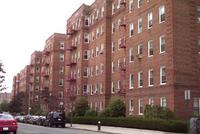 rows of apartment buildings; the dream of the Real Good Company, realized.
rows of apartment buildings; the dream of the Real Good Company, realized.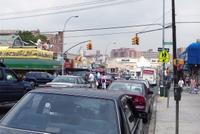 Rego Park is located at the convergence of Queens Blvd., Woodhaven Blvd., and the Long Island Expressway. Additionally, the New York City Subway runs beneath Queens Blvd., making Rego Park a central location in which to live and commute. Once development began, the
Rego Park is located at the convergence of Queens Blvd., Woodhaven Blvd., and the Long Island Expressway. Additionally, the New York City Subway runs beneath Queens Blvd., making Rego Park a central location in which to live and commute. Once development began, the 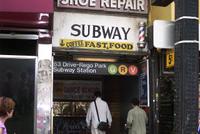 neighborhood saw a growth in Italian, Irish, Romanian, Albanian, and German immigrants. Since the 197os, the area has become increasingly multi-ethnic including a growth in the Chinese population. I hope the new Chinese settlers aren't here in response to a delayed telegram from their ancestors telling them how rich the soil was here for planting.
neighborhood saw a growth in Italian, Irish, Romanian, Albanian, and German immigrants. Since the 197os, the area has become increasingly multi-ethnic including a growth in the Chinese population. I hope the new Chinese settlers aren't here in response to a delayed telegram from their ancestors telling them how rich the soil was here for planting.Queens Blvd. is perhaps the most intimidating road in Queens. It averages a width
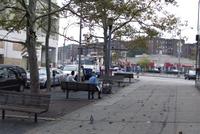 of 200 ft., with six lanes of express traffic, and two lanes for local access. It's like a superhighway with traffic lights and intersections. It muscles its way from Sunnyside to Jamaica with force, sometimes even deadly force. The New York Daily News has labeled Queens Blvd. "The Boulevard of Death," because of the volume of pedestrian casualties in recent years.
of 200 ft., with six lanes of express traffic, and two lanes for local access. It's like a superhighway with traffic lights and intersections. It muscles its way from Sunnyside to Jamaica with force, sometimes even deadly force. The New York Daily News has labeled Queens Blvd. "The Boulevard of Death," because of the volume of pedestrian casualties in recent years.The Long Island Expressway
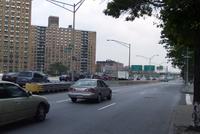 provides additional car and truck access to Rego Park, though most commuters would not necessarily label it "efficient," commuting.
provides additional car and truck access to Rego Park, though most commuters would not necessarily label it "efficient," commuting.Woodhaven Blvd., a road with only slightly less moxie than Queens Blvd. also gives
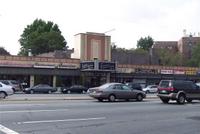 residents in Rego Park a means to reach other parts of Queens. In this picture, looking across Woodhaven Blvd., the Italian restaurant on the left has clearly grown large enough to move into what used to be the Drake Theater (click on photo to enlarge). I think the Drake was still there when I left for Mississippi though I'm not positive.
residents in Rego Park a means to reach other parts of Queens. In this picture, looking across Woodhaven Blvd., the Italian restaurant on the left has clearly grown large enough to move into what used to be the Drake Theater (click on photo to enlarge). I think the Drake was still there when I left for Mississippi though I'm not positive.There were no multiplex theaters when I was growing up and the Drake, like most others, was a single-feature movie house. When we went to the movies, we never went one place frequently, rather, we went several places occasionally. I'm sure I went to the Drake more than once, though I know I was there at least once because I distinctly remember seeing Hal Lindsey's The Late, Great Planet Earth there when I was in grade school. It scared the life out of me at the time, though my theology has developed significantly since then. Other things scare me now.
This is the Rego Park Recreation Center. Many neighborhoods in Queens have recreation centers, but this one is unique, not only because it offers boxing, but because it is in a
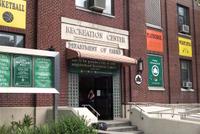 building called the Lost Battalion Hall.
building called the Lost Battalion Hall.It is named in honor of the "Lost Battalion," a band of 600 men from the 77th New York Regiment who became isolated during the battle of Argonne in WWI. They refused to surrender, though they had no food, shelter, limited water and communicated exclusively by carrier pigeon. Between Oct. 2 and Oct. 7, 1918, the battalion lost more than 400 of its original 600 soldiers. The regiment was lead by Major Charles Whittlesey, who committed suicide on Nov. 29, 1921.
This is Lefrak Tower. In fact, the name Lefrak is commonly seen in various locations in Rego Park. Harry LeFrak developed the first commercial tower in Rego Park and established the Lefrak Organization who took the development ball in Queens and ran with it. In the mid-1960s, under the direction of Harry's son Sam, the company made its biggest mark on the Queens lan
 dscape. Building on 40 acres of land North of the Long Island Expressway, Lefrak City contains 20 apartment buildings, 18 stories each for a total of 5,000 apartments and is home to more than 14,000 people. At the time of its development, Sam LeFrak said, "I produce an apartment every 16 minutes."
dscape. Building on 40 acres of land North of the Long Island Expressway, Lefrak City contains 20 apartment buildings, 18 stories each for a total of 5,000 apartments and is home to more than 14,000 people. At the time of its development, Sam LeFrak said, "I produce an apartment every 16 minutes."Today, the Lefrak Organization has been listed by Business Week magazine as one of the top 50 family-owned companies in the U.S. with an estimated value of $3.8 billion.
Speaking of fam
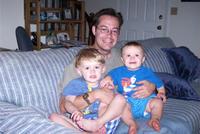 ily business, one of the nice things about living and working in New York is my proximity to family. My sister Jane, her husband Trevor and their two sons, Tyler (3) and Zachary(1) live in Old Saybrook, CT and I paid a visit last weekend. I didn't have much opportunity to visit them when I was in seminary in Mississippi. I can visit more often now.
ily business, one of the nice things about living and working in New York is my proximity to family. My sister Jane, her husband Trevor and their two sons, Tyler (3) and Zachary(1) live in Old Saybrook, CT and I paid a visit last weekend. I didn't have much opportunity to visit them when I was in seminary in Mississippi. I can visit more often now.PRAYER CONCERNS: Please keep our church plant in your prayers. Our launch date is swiftly approaching. I ask also for continued prayers for my fundraising efforts (I'm still short on the funds I need). Most urgently, though, I ask for prayer for my Brother-in-Law Alex, who had a heart attack last year and has had continued heart trouble since that time. He's a reasonably young man. Keep my sister, Charlene (his wife) in your prayers as well as she helps him though his medical procedures and assists him along the way.
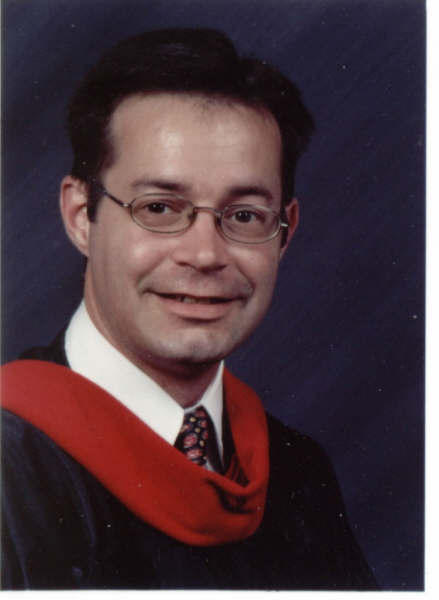

1 Comments:
dude. Macy's is having a one-day sale on Wednesday. Wanna get some black shirts? oh, and nice Welcome to Queens pic. Very nice.
Post a Comment
<< Home